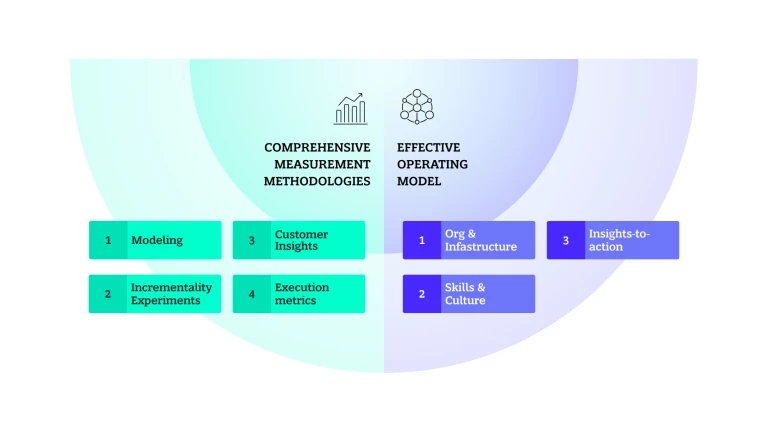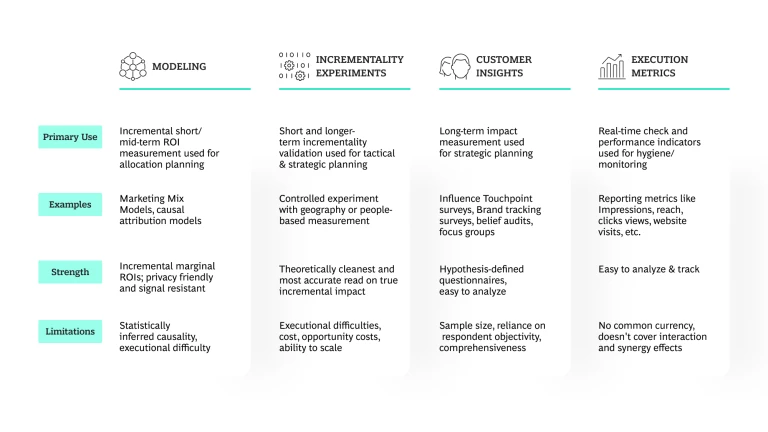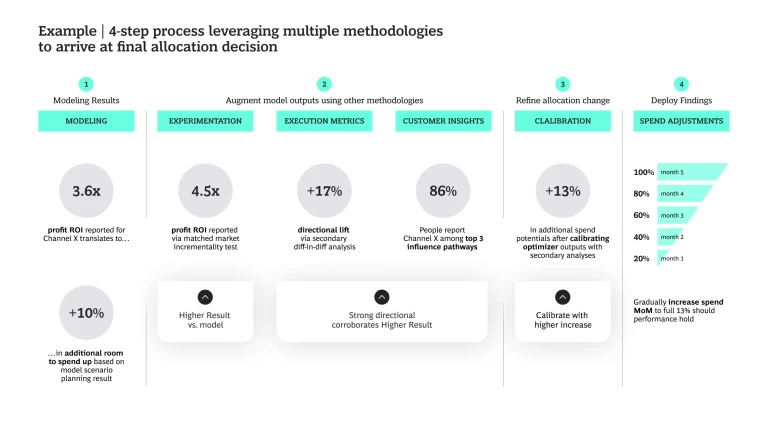Marketing spend is often one of the largest line-items in a P&L, typically ranging from 5% to 15% of revenues depending upon the industry, company size, and maturity. The fact that its impact is notoriously difficult to measure often causes the CMO/CFO relationship to be one of the most strained in the C-Suite.
Marketing can often be painted as a cost center, rather than a profit center. In times of uncertainty when companies face pressure to pull back expenditure or rethink budgets altogether, marketing cost becomes an easy target. CMOs often struggle to resist such budget cuts if they cannot articulate the real impact and ROI of marketing cost, and whether marketing spending can be dialed down to finance cost-cutting efforts — or if it is an essential investment that must be safeguarded to avoid negative topline impact.
The answer lies in effective measurement: if CMOs can assign a true ROI to Marketing cost, they can inspire confidence in the decision-making process for marketing allocation, even in trying times.
Common Challenges
Marketers often struggle to answer several key questions, including:
- How much to spend? How much should our organization spend on marketing to reach our goals? Should we spend more to take market share from competitors? Less?
- Where to spend it? Which channels and tactics should be prioritized? Which have the best ROI?
- How to measure impact? How do we measure marketing’s contribution to our bottom line? How do we know which methods to trust?
In trying to answer these questions, marketers must address two key obstacles:
- Competing Signals drive “data overload”: Different measurement and attribution methods can cause confusion. Varying levels of detail, from broad aggregate summaries to highly granular individual interactions, pose a challenge in finding the right balance to drive actionable insights.
- Operating Model inhibits finding answers: Lack of shared vision and of common currency across departments, along with varying levels of trust for different data sources, can impede accurate assessment.
The ability to overcome these challenges and assign a true ROI to marketing lies in accurate marketing measurement . Organizations must leverage a set of comprehensive measurement methodologies and an effective operating model to accomplish this. In this article, we’ll discuss an approach to utilizing certain methodologies that make up a portion of BCG’s Holistic Marketing Measurement approach.

Measurement Methodologies: The “four-legged stool” of marketing measurement
We have found that there is no “one-size-fits-all” solution. Marketing is, after all, part science and part art. In our experience, it is best practice is to combine multiple measurement methodologies to triangulate results and validate impact from different perspectives. Four specific perspectives comprise what BCG refers to as the “Four-Legged Stool of Marketing Measurement.”
- Modeling captures the ROI of marketing channels in one model to inform spend allocations, while controlling for other internal and external factors. Marketing Mix Models (MMMs) are generally trained at the aggregate channel or tactic level. Most models are built to estimate the incremental contribution and ROI at the channel level (e.g. Digital Video, Search, Print) but not the impact of individual tactics or media placements. MMMs can generally be trusted as a guiding hand to inform allocation.
- Incrementality Experiments offer the cleanest read on true incremental ROI, but can be complex to set up. Because models like MMMs use historical data to infer causality, the results are typically less precise than in a controlled experiment. Incrementality testing reveals the true incremental and causal impact of specific marketing channels and tactics. As such, these experiments can be used to calibrate the MMM and improve precision, while providing a snapshot-in-time read on Marketing impact and ROI for any given channel.
- Customer Insights aid in long-term strategic planning through surveys, focus groups, and belief audits. This type of insight provides deep understanding of the drivers of choice and the impact of certain marketing touchpoints on business outcomes. For example, customers might report being more influenced by channels like Digital Video than by Direct Mail. In combination with other metrics like BCG’s First-Fast-Response , methods like these can help validate experiment findings and measure the longer-term impact at the channel and tactic level.
- Execution metrics facilitate near real-time performance monitoring for KPIs like impressions, clicks, leads, and purchases. These metrics are commonly sourced from Media Platforms themselves or attribution tools that help tie revenue to recent marketing touchpoints (e.g. click-based or view-based attribution). They are most useful for monitoring short-term marketing impact using many different indicators such as clicks, website visits, and other signals. But these metrics are hard to trust due to fundamental tracking shortcomings and to the self-reporting nature of digital marketing channels: many marketers are familiar with their bias to “steal credit” for attribution, which makes it difficult to isolate real impact.

Better Together: Combining methodologies to create a holistic view
Too often, marketers fall into the trap of leveraging whichever measurement tool is most readily available. Reliance on a single method, however, introduces bias and significant risk. When a tool is used in isolation, its strengths and limitations can paint an incomplete picture.
By integrating all of these methodologies, marketers can gain a more comprehensive, accurate assessment of their performance. This holistic view enables more informed and strategic decision-making, ensuring that all aspects are considered.
Here is an example of how to use the Four-Legged Stool Framework to validate and calibrate the output from a Model:

Provide an effective operating model
In addition to building a cohesive measurement framework, organizations must enable their teams with an effective operating model. As with any digital transformation, each measurement journey is different, shaped around an organization’s starting point, circumstances, and goals. But most successful transformations are connected by a single thread: they dedicate 10% of the effort to algorithms, 20% to data and technological backbone, and 70% to business and people transformation. BCG has found that this "10/20/70 rule" leads to such positive results that it forms the core of our approach to digital and AI transformations.
To successfully capture the value of elevated marketing measurement, we suggest taking the same approach. That is, most of the resources should be dedicated to people. This can be accomplished by focusing on three areas:
- Skills and culture: Ensure that the team is ready, willing, and able to embrace and optimize measurement practices, thus promoting a culture of continuous improvement.
- Org and infrastructure: Establish clear roles and responsibilities across teams (e.g. media, analytics, sales enablement, customer experience). Proper org design helps ensure effective data management and analysis, enabling actionable insights.
- Insights-to-action: Avoid analysis paralysis: Develop the capability to convert data insights into actionable marketing strategies. Focus on ROI-centric planning and decision-making processes to drive better outcomes. Build frequent reviews and refreshes into the process.
Tangible, measurable benefits
Recently, BCG X.Growth and X.Delivery collaborated to build and deploy a holistic measurement approach for a leading MedTech company. The work was comprised of three main modules designed to work together to measure and enhance total marketing impact:
- Build and deploy marketing-mix models as a part of the four-legged stool approach
- Enable teams to run mix scenarios and determine optimal marketing allocation
- Guide and implement advanced data-driven marketing capabilities, including KPI metric frameworks, incrementality testing methodologies, media optimization tactics, and MarTech assessments.
These modules were designed to work together to measure and enhance total marketing impact. We helped uncover a $75M profit opportunity (+6%) through reallocating budget.
Use a holistic approach to measure and optimize marketing spend
In today's economic climate, effective marketing spend measurement is not just beneficial: it is essential. By adopting a comprehensive, multi-faceted approach, CMOs can transform marketing from a perceived cost center into a demonstrable profit center. The “Four-Legged Stool” framework, which encompasses modeling, incrementality experiments, customer insights, and execution metrics, provides a powerful and comprehensive method to triangulate and validate marketing ROI. When integrated within an effective operating model, this approach enables more strategic decision-making. Embracing this holistic strategy ensures that marketing efforts are accurately measured, optimally allocated, and ultimately drive significant business value.


